How to price your online course in 2026? (+ real examples)
Learn how to price your online course effectively, attract serious students, and scale your income like top creators hitting $10K+/month.

I get it. You want to spread your tentacles. You want to price your online course so you’re bringing in about $10,000 every month.
Trust me, that’s not overkill. Many coaches, influencers, and course creators are hitting $40,000 to $120,000 per year once things are rolling.

That’s easily $3,000+ to $10,000 per month. You aren’t any different from these creators. But if you want to make similar profits, you have to get four key factors right.
First, you should sell your course on the right platform. Second, your online course has to offer real value to learners.
Third, you need to discover how to price an online course effectively. And finally, keep reading this article because I’ll show you how to do just that.
Common questions regarding online course pricing
Before I talk in detail about how to price an online course, let me answer some common questions you may have in mind:
1. What is a good price for an online course?
A good price for an online course is usually between $50 and $200. Advanced or specialized courses can cost $300 or higher.
Can I charge a premium price if I'm not a well-known expert?
Yes, you can charge a premium price even if you’re not a well-known expert. Your pricing is justified as long as your course offers real value to learners.
2. What is the best pricing model for an online course?
The best pricing model for an online course is a one-time payment.
That’s because it’s easier for learners to pay for lifetime access. A one-time payment also removes buyer hesitation since the pricing feels fair and transparent.
3. Should I offer my first course for free to build an audience?
You should only offer your first course for free if it’s a mini-course. Full courses may not attract serious learners if you offer them for free.
4. Can I raise my course price later?
Yes, you can raise your course price later if it’s a one-time fee.
When you add more value to your course, you can increase the price for new buyers. You can let old students keep their access while new buyers pay the updated rates.
For example, let’s say you launch your course at $100. After you get testimonials, add templates and e-books to your course, you can sell it for $200.
The (old) students who paid $100 keep their lifetime access, but new students will pay your new one-time fee.
5. Should I offer discounts or run sales?
Yes, you can offer discounts or run sales. However, it shouldn’t be all the time, as they can impact revenue negatively.
You could run sales or discounts on special dates like Black Friday or Cyber Monday.
6. Why are courses on Udemy so cheap? Should I match them?
Courses on Udemy are so cheap because the platform makes money by selling many of them at low prices.
No, matching them would mean selling your courses at considerably low prices. This may not be the best approach, especially if you are only starting.
How to price an online course
Suppose you want to price your online course effectively, you need a plan. Speaking of planning, I’ve laid out six actionable steps you can follow. These steps are:
- Study your market
- Check if your audience is willing to pay for your course
- Determine your course’s value and outcome
- Choose your pricing model
- Increase the course’s perceived value
Now, let me walk you through each step.
Step 1: Study your market
When I say study your market, I mean research the online courses already out there. Then check who it’s for and how much people are paying for the same or similar results.
Here’s a table I put together to give you a fair idea of the various course types on the market:
An example of mini courses is Brandon Birkmeyer’s “How to Make a Mini Course in 40 Minutes” on Udemy. It costs $19.99, and it teaches beginners how to create mini courses in 40 minutes.

When I think of certification programs, this course from the London School of Business and Research (LSBR) comes to mind. It costs about $2,630, and it’s for professionals in the occupational health and safety management industry.

Basically, the point is that you need to understand the market you're selling to. Once you know your market through and through, you’ll have a good idea of how to price your course. After all, you wouldn't price a Bugatti Tourbillon the same way you’d price a Kink Williams BMX bike.
Your price should reflect your audience, your competitors, and the value you provide to learners.
For example, an intermediate-level online course on creating engaging social media videos may cost around $189 (697 PLN).

But an online bachelor’s degree course in Finance, Investment, and Banking could cost about $37,531.

Clearly, these are entirely different markets. One targets social media creators who want practical skills, while the other appeals to students seeking formal education.
That should give you a fair idea of how much to charge depending on your market.
Step 2: Check if your audience is willing to pay
The next step is to check if your audience is actually willing to pay for your course. Let's say you want to create and sell a course on “How to Build a Personal Brand on LinkedIn.”
You may already have 3,000+ followers, but you cannot assume that they will buy your course.
You have to check if they will buy by first asking them directly. How do you do this? Run polls, surveys, or simply ask on social media.
For example, you can just make a post asking,
“If I were to create a step-by-step course on building your personal brand, would you be interested? And how much would you pay for it?”

You could also chip in a question about what price they’d be willing to pay, like I did.
To do this, take a step further by checking how much they’re willing to pay with a pre-sale. Even before you build the course, you can create a landing page that explains what the course is about.
Then you can add a “Join the waitlist” button and a “Pre-order now for $50” call to action.

If people sign up, then you know your pricing works.
Kamila Paradowska, for example, ran a pre-sale with Easycart to be sure her audience would pay for her content design course.
She even published a blog post explaining what her course covers.

When she sold all the spots in three hours on the first day, she knew her audience wanted what she was offering. And she was right. She made $13,000+ after she launched the course.

Another thing you could do is to look at what creators in your niche are doing. What they’re selling to their audience, and the reviews they’re getting.

Take our clients’ “Vertical Filming” course, for example. In the first week of launch, 1,400 people bought the course.

It’s proof that the course is something people want.
You could also test small offers. Instead of a full-blown intermediate skill course, you could start with a mini course and peg it at $20 to $40.

If you want to experiment more with the pricing, set different pricing tiers. The basic version with the videos can be $50.
The Standard plan at $100 would have worksheets and templates. The Premium plan at $200 would offer everything plus live Q&A sessions.
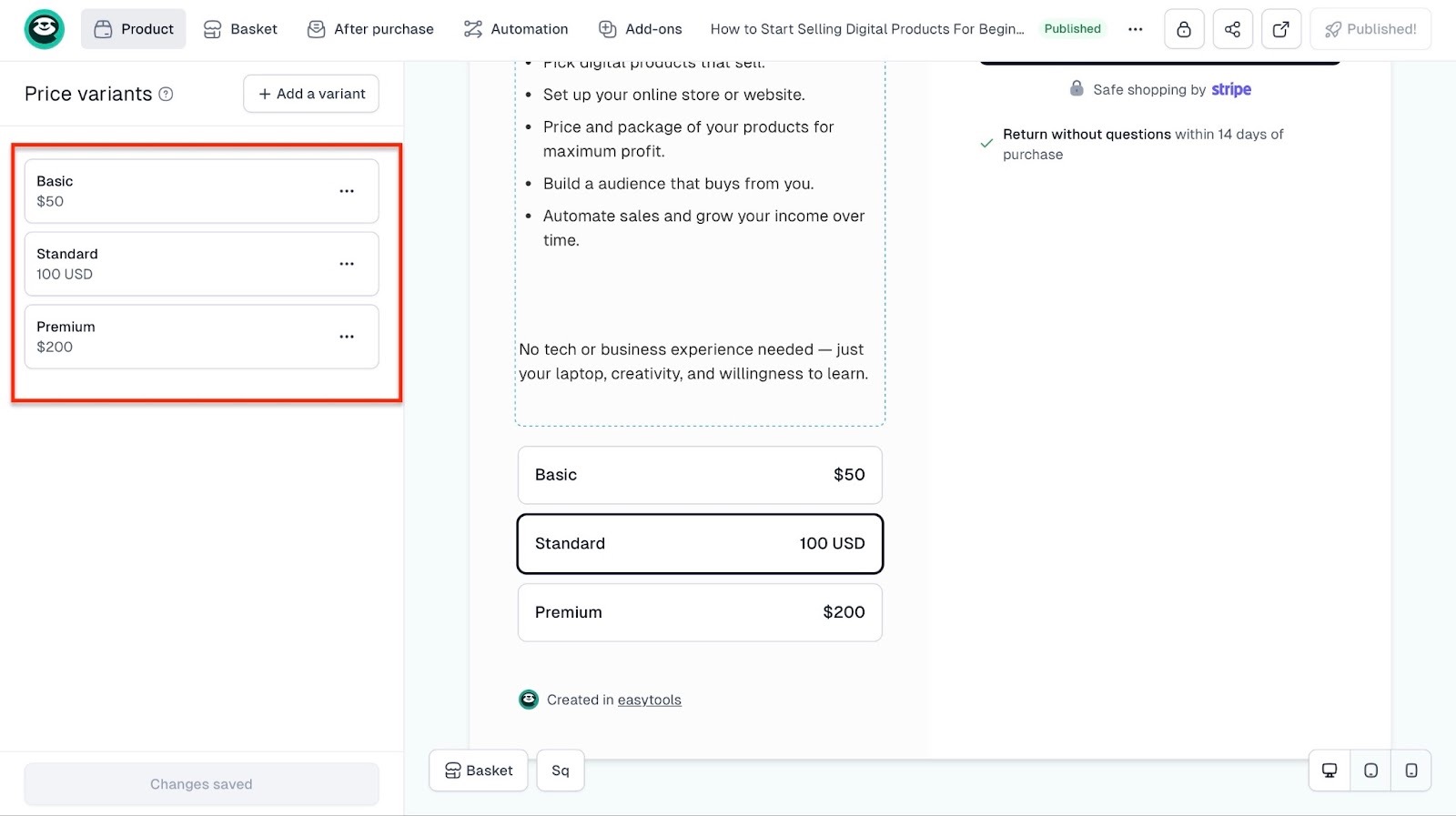
All this is to help you see the tier your audience prefers. Which in turn will let you know how much they’re willing to pay.
Step 3: Research how much your competitors are charging
You should research how much your competitors are charging for an online course.
If you did a good job in step one and really studied your market, then you should know your competitors. The next thing is to find out how much they’re charging.
And you need to go a step further by researching why they charge that amount.
You don’t have to copy their price or anything. You just want to know the price that your audience may be familiar with. That also includes prices they expect to pay.
You can start by searching on popular platforms like Udemy, Coursera, or Alison.
These platforms have a global audience, so you’ll really get a broader perspective of price ranges. It is worth noting that the likes of Udemy largely offer courses at much lower prices due to their global scale.
But we’re looking for a range, so that shouldn't be a big deal.
For starters, go to Google and type “Udemy Courses.” After that, select “Browse All Courses.”

This will take you to Udemy’s website. Go to the search bar and type a keyword that describes your niche.
For example, you could type “fitness.”

In the new window, you'll see the search results and the course prices.
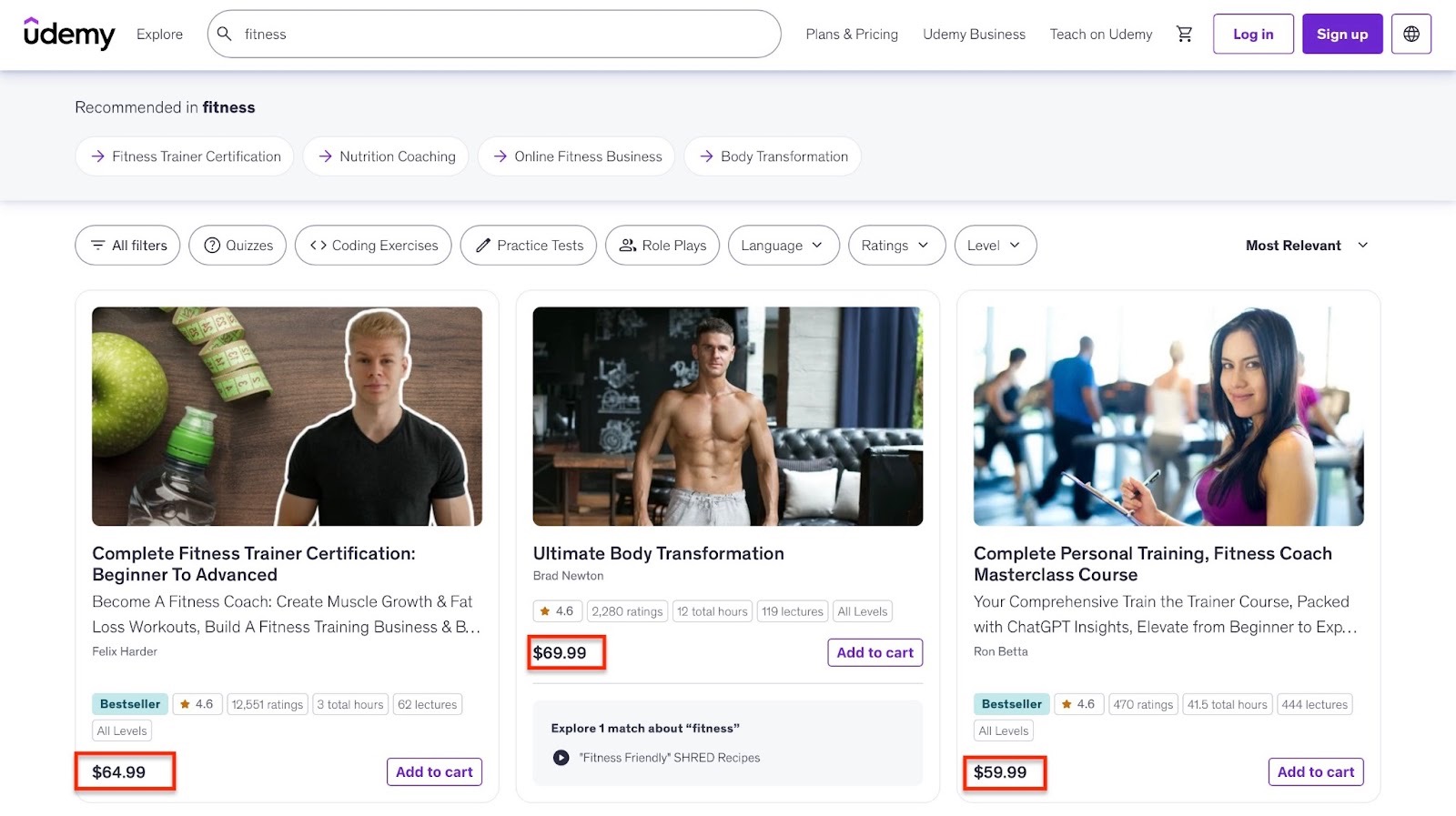
For fitness courses, I found that prices on Udemy range from $19.99 to $100+.
You can narrow your search down by clicking any of the buttons at the top of the window. Let's say you’d like to know the fitness courses that award certificates.
The next thing is to find out why your competitors charge these fees. For example, if you found an online fitness course going for $79.99 with 1,112 students already signed up, you’d like to know why.

Daniel Joshua Smith’s fitness course, for example, costs $89.99. That’s actually high by Udemy standards. Daniel’s students will get:
- A certificate of completion
- Full-time access
- Access on mobile and TV
- 30-Day Money-Back Guarantee
- 4.5 hours on-demand video
- An article
- Assignments

All of these offers help justify why he’s asking for a premium fee.
On other online course-selling platforms like Easytools, Podia, and Kajabi, course creators in the fitness niche can charge from $200 to $1,000+.

Coaches can charge that amount because they can deliver on their promises.
And there are other profitable niches as well. Here’s a table with some examples, the usual price range the course creators charge, and why the price range works.
Next, check which platforms your rivals sell their courses on.
For example, our platform, Easytools, is used by:
- Independent course creators and entrepreneurs who want a simple, low-tech, no-code way to launch a course
- Digital creators like influencers, coaches, marketers, and developers who sell niche knowledge and skills
- Creators who want control of their audience, customers, and pricing
One of our customers, Bart Rycharski, CEO and founder of BRAVE.courses, uses Easycart for his company.
BRAVE.courses focuses on online education through cohort-based programs and working with expert mentors to create high-quality courses.

When I interviewed Bart, he told me that Easycart helped his company achieve a 60% conversion rate compared to when they were using just Stripe Checkout.
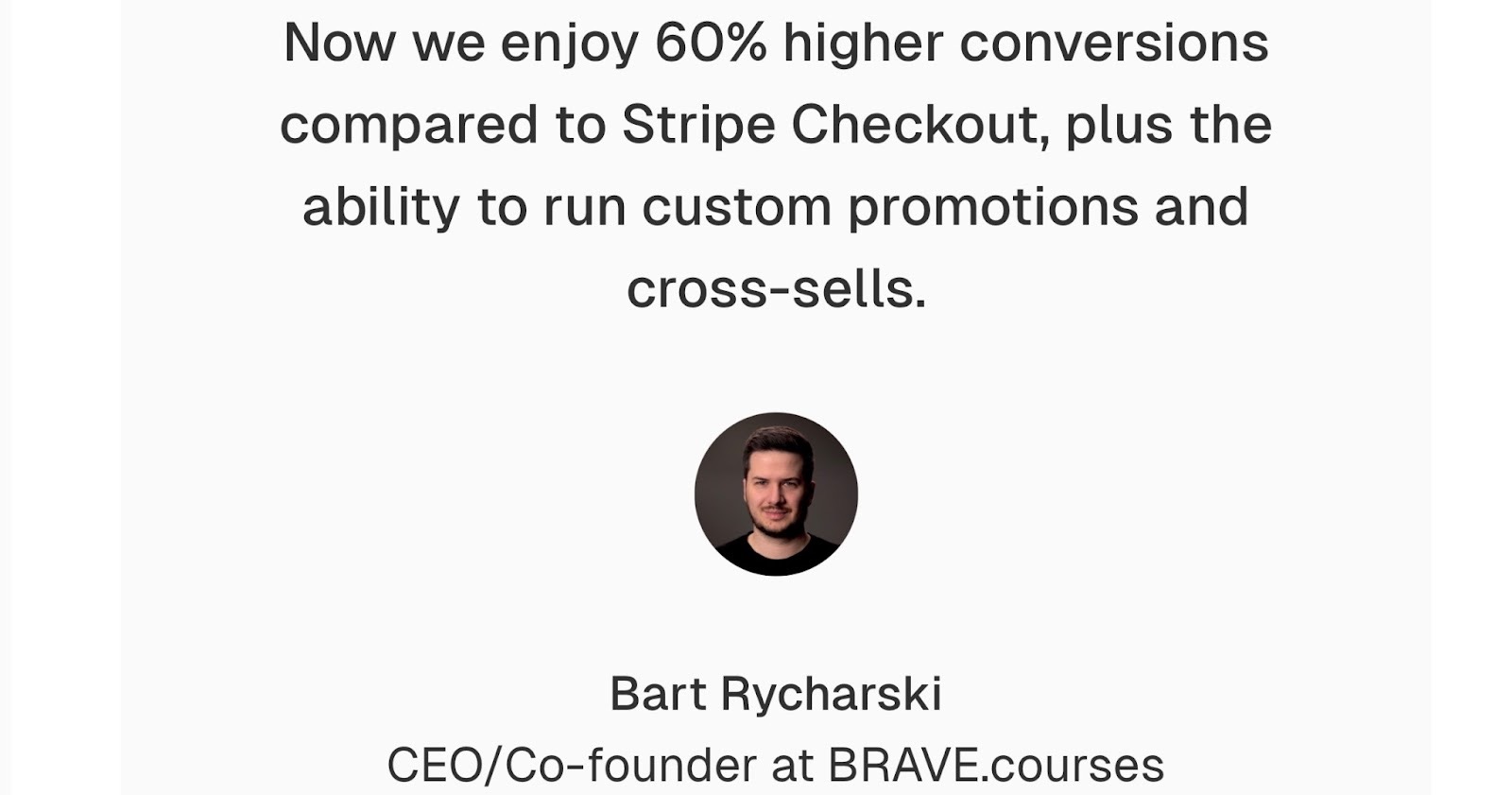
BRAVE.courses sells high-quality courses, and when paired with a 1-click checkout, that’s a winning combination.
To wrap this up, your research should show you what your competitors are charging and why.
It should also help you understand what it takes to price your online course at or above the market average.
And finally, it should help you know which platforms give you control to price your online course at your own rate.
Step 4: Determine your course's value and outcome
The fourth step is to determine your course’s value and outcome. And that's because learners are paying for results, not just information.
You can price an online course higher if the outcome it offers is clear to see.
For example, a $19.99 course might teach “How to Play 5 Classic Blues Riffs on Guitar.”
On the other hand, a $290 course could teach, “How to Master Fingerstyle Blues and Build a 6-Song Performance Repertoire You Can Use to Get Paid Gigs.”
Martha Krawczyk, one of the designers on Design Practice, created “Ads for Creatives.” The course’s description says,
“You will learn to promote your own services and build your visibility on social media - without shame and burning your budget.”

It makes you realize instantly that the $19.99 course offers skills and knowledge. But Martha’s course and the Fingerstyle course I mentioned promise clear results.
No wonder “Ads for Creatives” has 370 people (and counting) on board, even though it’s priced at $350 (1,290 PLN).
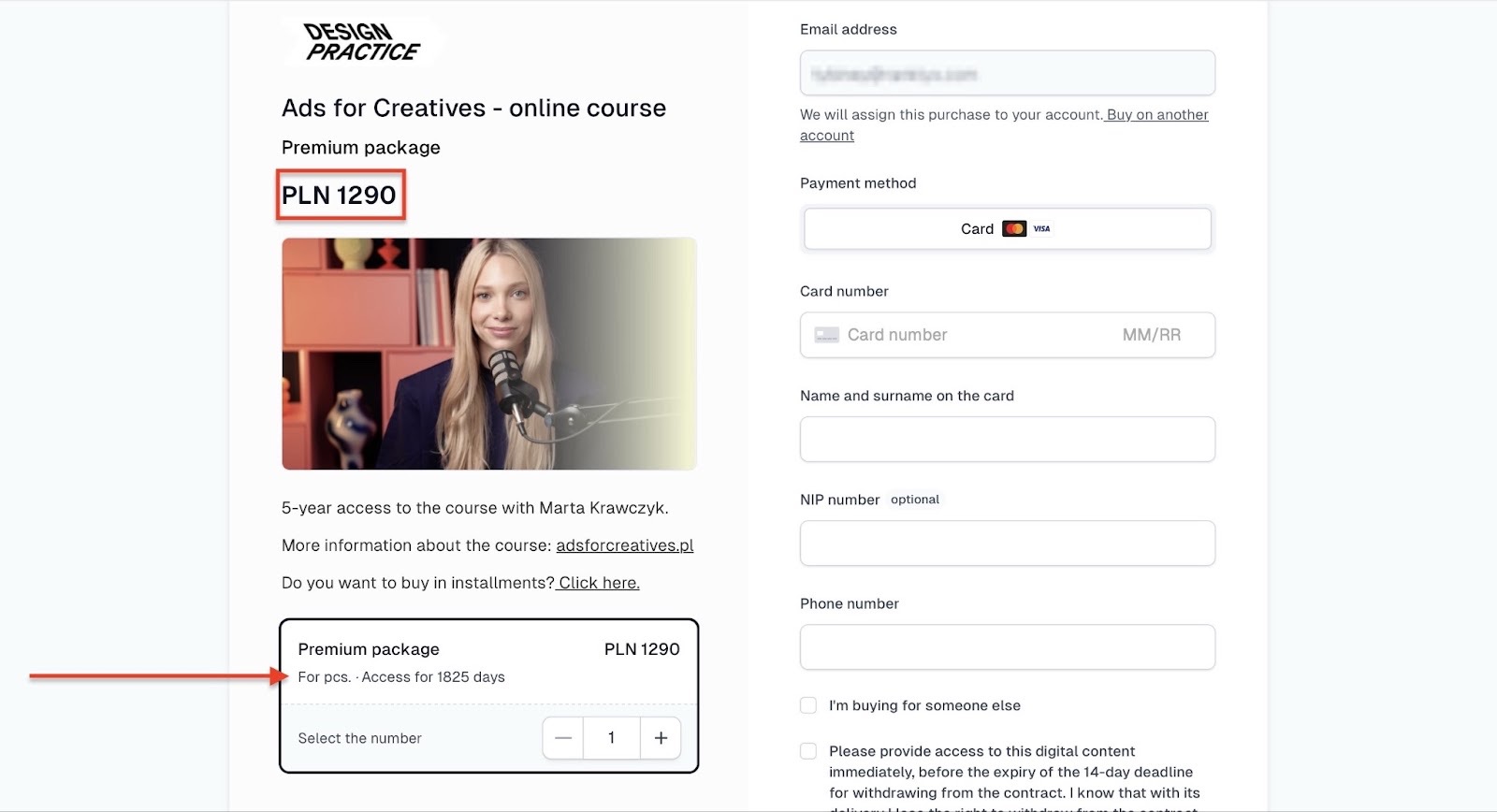
To determine if your course has value, ask yourself these questions:
a. What results will students get after taking my online course?
For “Ad for Creatives,” learners will increase their income. They’ll also gain a market advantage and won’t have to wait for social media algorithms.
You can use this response as a guide to think about what yours offers.

b. How much time and money will it save?
Here, you need to think about how value can be measured. Say your course makes designers create new work 5x faster, or it cuts creation time in half.
For “Ad for Creatives,” the answer is that learners will get a 6 to 10x return (in ad investment) because they learn how to create ads that target the right audience.

c. How fast can they achieve the results my online course promises?
Think about whether learners who take your course can start applying what they learn in a week or a month. The key here is to be honest with yourself.
If your course still needs work to give learners the results you promise, put in that work.
d. Is it a necessary skill to have, or is it just nice to have?
This question is important because must-have skills command a higher price. Nice-to-have skills do better when they’re priced lower.
So from the get-go, ensure your course teaches an essential or valuable skill. That could be the big step that gets you closer to the $10,000 per month mark.
Step 5: Choose your pricing model
Now that we've determined the course’s value, it’s time to choose a pricing model. You can’t price an online course if you don't know how these models work.
So, the pricing model you’ll choose will determine when and how often customers pay for your course.
The table below should help you get a better picture of online course pricing models.
You have to choose a pricing model that fits your course type, audience, and your income goal.
If you’re just starting, I’d recommend a one-time payment fee. It’s easier to manage, and you start making money fast.
Also, there you don’t have to worry about tracking monthly payments and cancellations.
We have successful customers who offer courses with one-time payments. Take Aga and Paulina, for example. They used Easycart to launch their cohort-based online course, “Digital Designer.”
They made $240,000+ in gross revenue selling to about 1,000 participants. It was a one-time payment of about $190 in two sales windows.

So one-time payments aren’t such a bad idea when you’re a beginner. As your brand grows, you can try payment plans, subscriptions, or live cohorts for higher profits.
Step 6: Increase the course's perceived value
The last but not least step to price an online course is to increase its perceived value. You simply have to make your course look and feel premium to achieve this.
A good start would be improving your course’s visual presentation.
Use legible typography, professional and original thumbnails, and branded colors. Ideally, these should be on your course’s landing page.

You can also use all the things I just mentioned inside your course platform. You want to record with good lighting and sound. If it’s a screen recording, ensure that everything is clear.

You also want the same quality in your marketing materials for social media, ads, and email campaigns.
Next, offer additional benefits, bonuses, and other digital products.
For example, one of the benefits you get from buying Martha’s “Ad for Creatives” is a five-year subscription to the course.
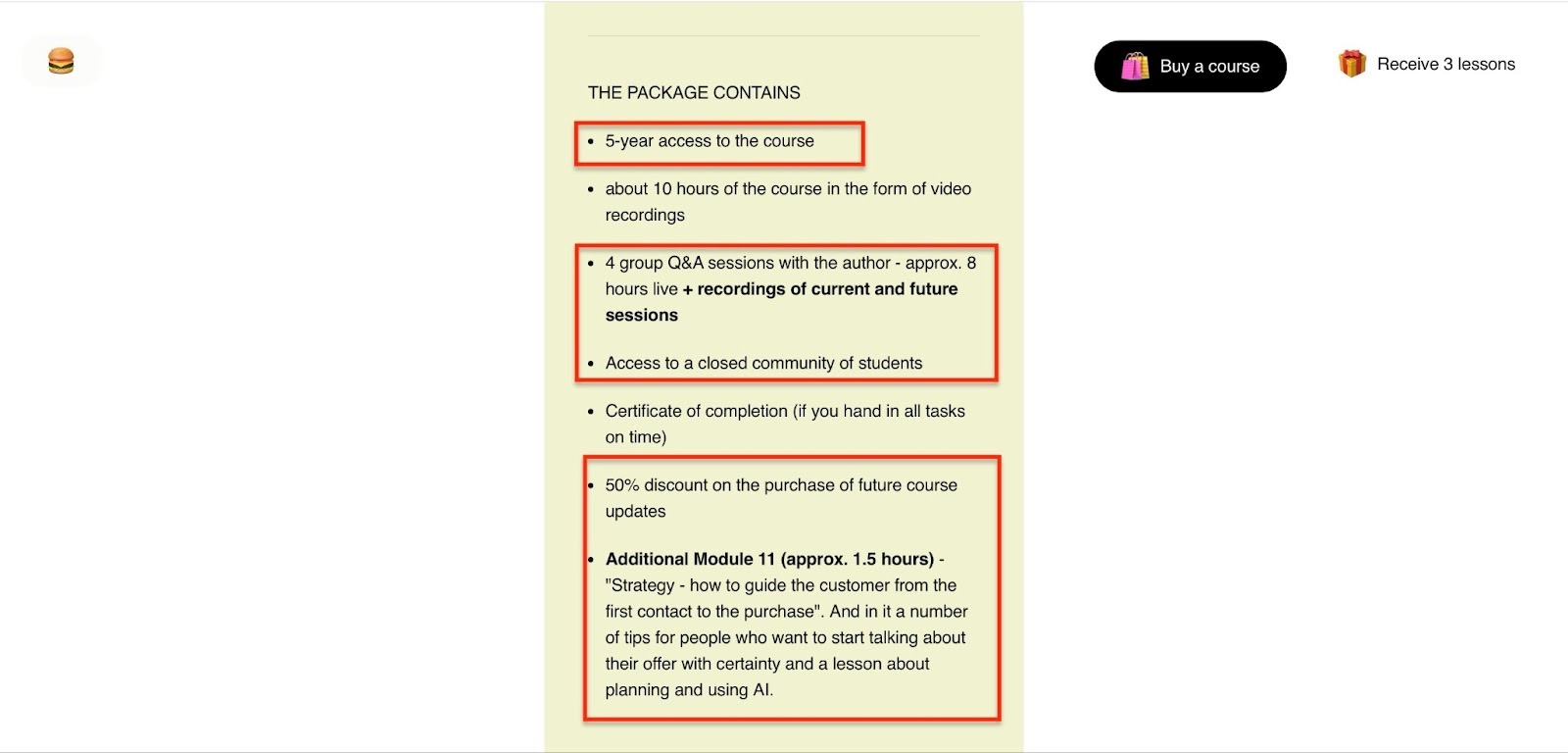
You also get access to a gated online community, a 50% discount on future purchases, a certificate upon completion, and more.

You could take a cue from Martha and add all those additional items. As for digital products, you can add templates, webinars, group coaching, etc.
Create a bundle by adding other courses together. After that, you can set up bundle pricing on Easytools in just 20 minutes.

Another thing you could do is show testimonials. Positive student reviews of your course confirm its value.

According to WiserReview, testimonials can increase customers’ trust by 72% and boost sales by 270%.

If you’re into fitness, text testimonials won’t be enough. You’d have to share before and after pictures of your customers on your landing page.
Sarah King, a fitness coach, for example, displays before and after transformations on her website. It shows the people she has helped.
And these are real customer stories and pictures.
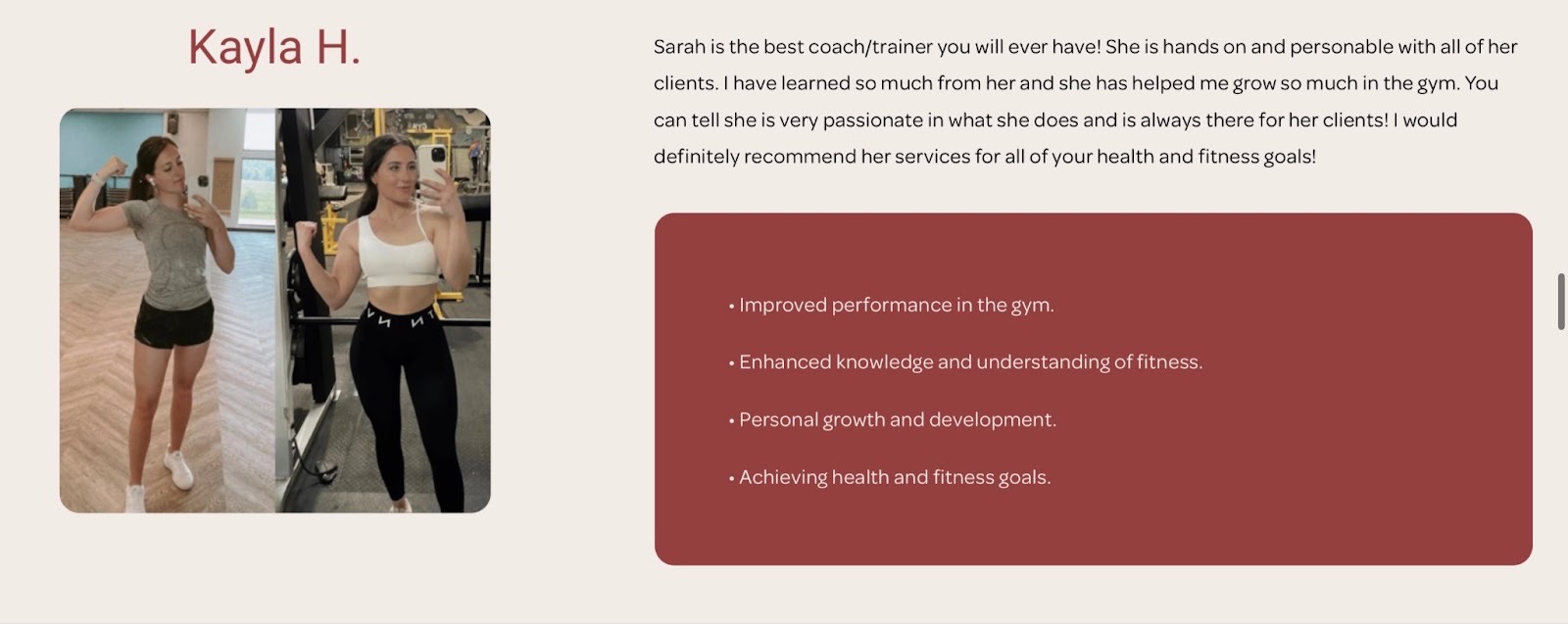
Once you have testimonials taken care of, offer different payment options. I’m talking about the whole nine yards.
Stripe, PayPal, Apple Pay, Google Pay, Easycart, etc. The easier it is for people to pay, the more likely they’ll actually buy.
Easycart, especially, will convert most of your leads and turn them into paying customers.
And there are solid reasons for that. Yes, from upsells, cross-sells, product variants, pay-what-you-want, and more.

Common course pricing mistakes to avoid
There are common course pricing mistakes you must avoid if you want to hit the $10,000 per month mark someday. In this section, I’ll talk about three key ones, which are:
- Lowering course prices in hopes of selling more
- Attracting uncommitted students with cheap pricing
- Making it hard to scale your income because your prices are too low
Let’s go through each point in detail.
Low price doesn’t always mean higher sales
When pricing an online course, don’t make it cheap just because you think it will increase sales.
When your price is low, learners could think your course is of low quality. I read a story in which a writer and course creator named Zita talked about this.
He said he decided to price his online course at $147. Apparently, it’s lower than most online courses in his niche.
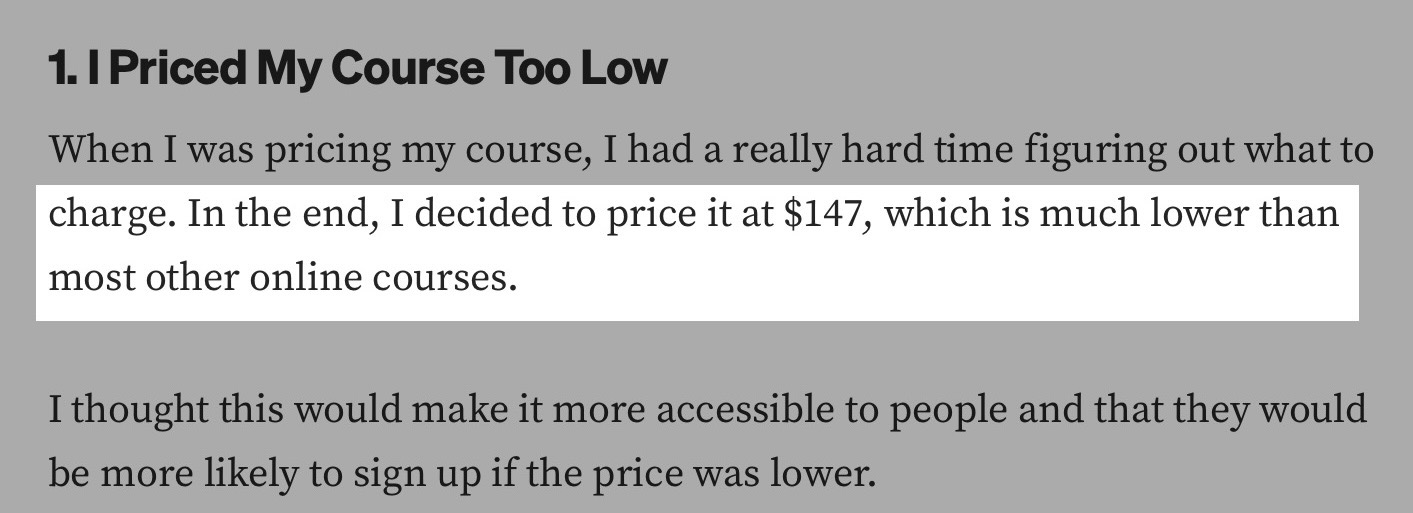
And yes, he found out that it was a mistake because he didn’t sell as much as he thought he would. He learned his lesson. So your pricing should reflect the value it provides. I couldn't agree more.
When you do the math, it really pays off to set your prices high. Here’s what I mean. Say you set your price at $100.
That means you need just 50 students to make $5,000. But if you peg it at $10, you’ll need about 500 students to hit that same amount.
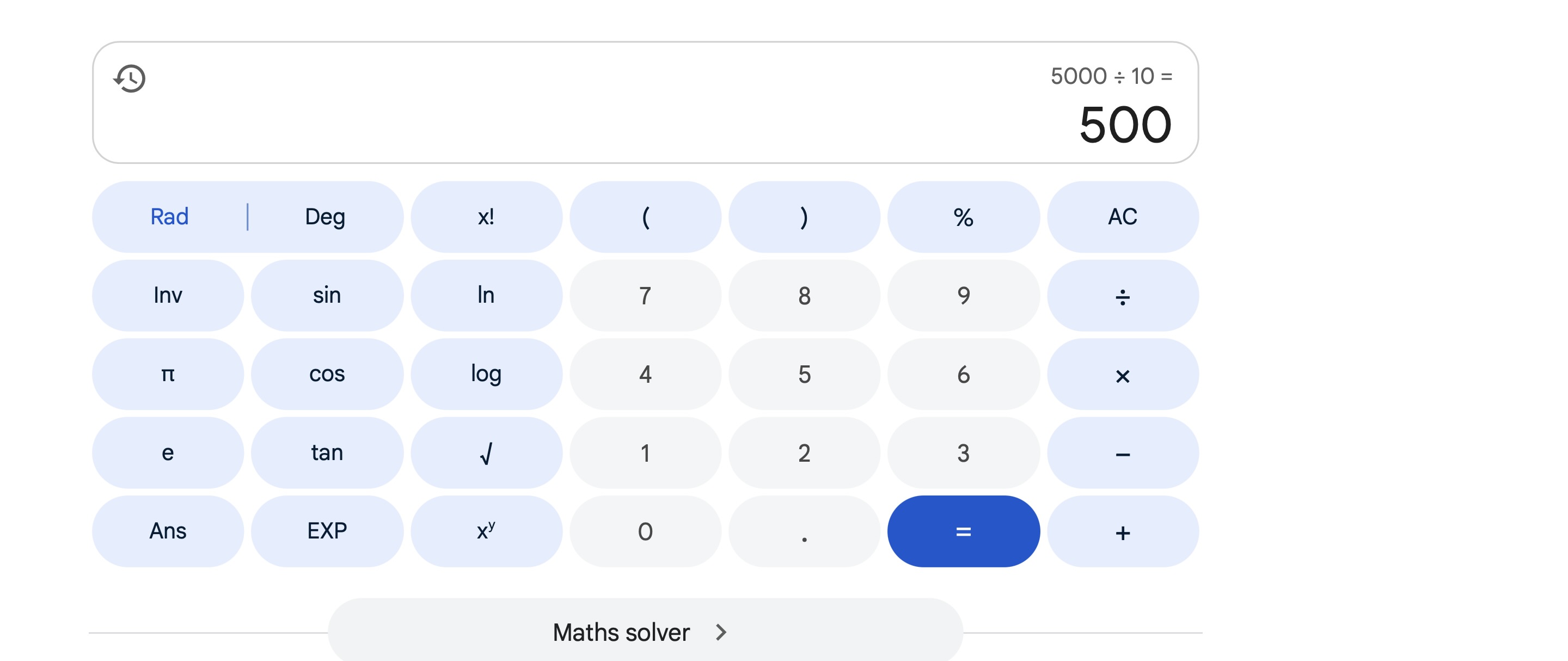
And believe me, it’s not easy to get 500 students, especially when you’re just starting out.
Another thing is that there are creators out there who started off with higher pricing, and their courses are selling in droves.
One typical example is Danielle Leslie. She made over $10 million in four years selling online courses.

She didn’t pull that off by selling courses for $10 to $30.
Now, she is the creator of “Course From Scratch.” It’s an online program that teaches coaches, consultants, influencers, and creators how to do what she did, which is simply monetizing their skills, building an audience from scratch, and so on.
What caught my attention is that Danielle promises to show participants how to price their course at “$500, $1000, or more.”

It can feel safer to lower the price of your online course, but consider these examples I’ve mentioned.
Cheap courses attract uncommitted students
One mistake that’s a consequence of setting prices low is that it may attract uncommitted students.
The kind of students who will skim your stuff and never come back. After all, it was just $10.
They might think they won’t lose anything if they decide not to go through with it. And you may feel that isn’t a big deal, but it is.
You want serious students: those who will actually go through your course and complete it.
They will definitely be the ones who find value in your course and leave you positive reviews.

Their success stories after applying what you teach and getting results are what will sell your course. Their positive reviews will attract new students.
Also, they will keep coming back if you launch new courses. Remember Daniel Joshua Smith, the fitness instructor on Udemy? He has about 52 students taking his latest fitness program, “Level 3 Certificate in Personal Training.”

But after I scrolled further down, I realized he has about 476 students who have taken his other programs.
He also has 30 reviews and a 4.4 instructor rating, obviously courtesy of these students.

I read two of the reviews, and they were positive enough to land another student.
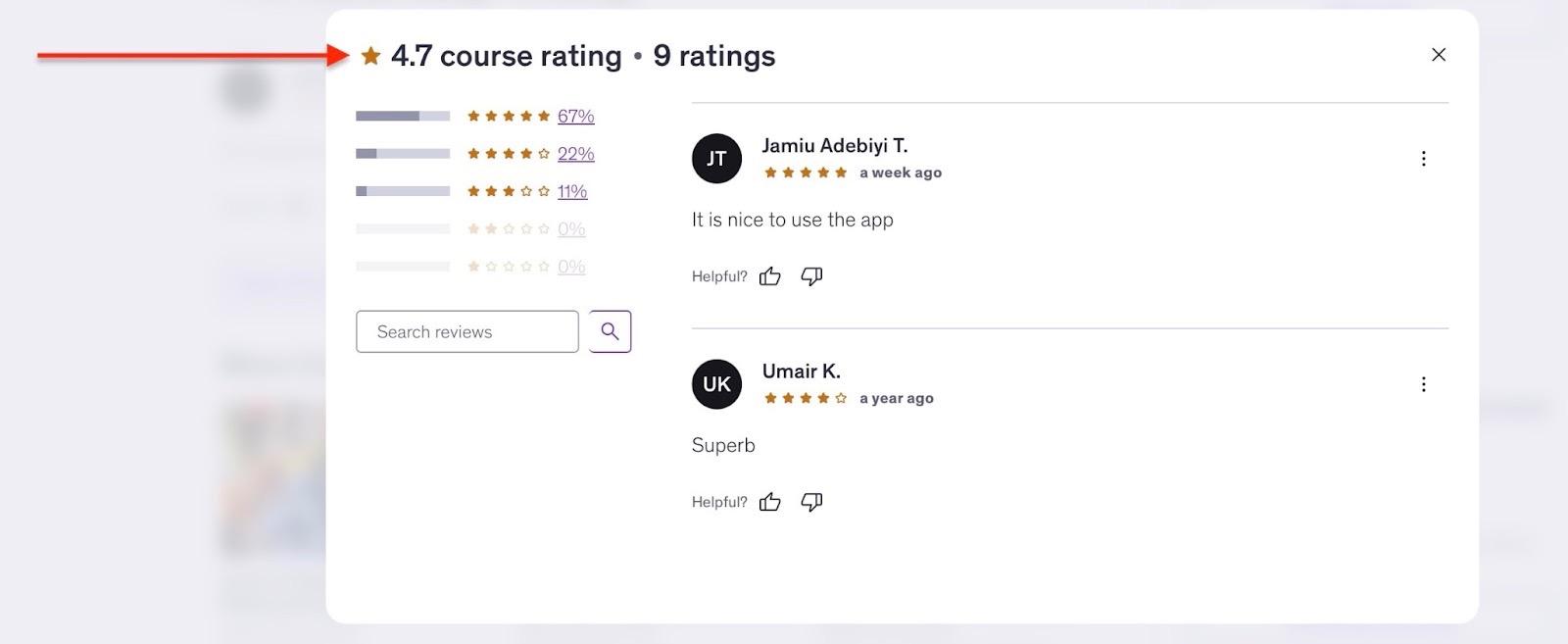
And that's the idea. If you attract uncommitted students, not only do you risk them dropping off, but they could also leave a negative review.
That can hurt you in the long run.
So I’ll recommend that you price your courses well to attract students who really want what you offer. Those students will commit.
Marcin and Przemek, founders of Przeprogramowani, have proven this. They sold their online program, 10xDevs, for $540 (1,990 PLN), and 2,525 people signed up.
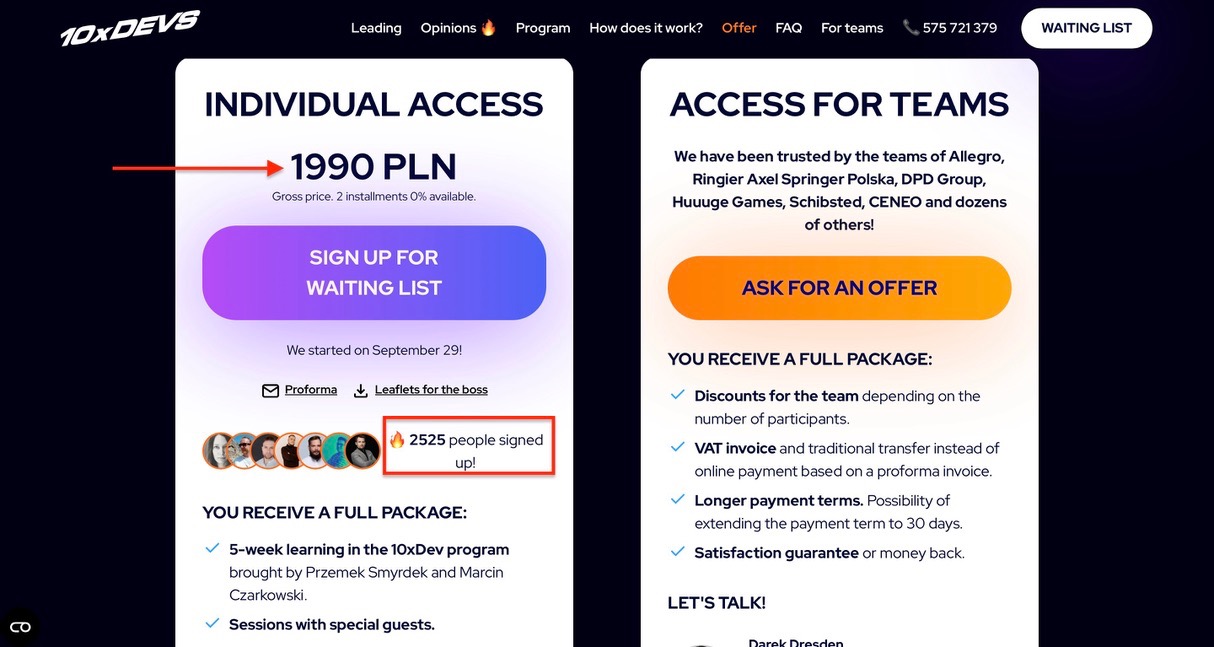
If you had any doubts, I hope this clears them up.
You’ll struggle to scale
Scaling comes easily if you can make good money and build an audience without increasing your workload.
For instance, let’s say you start off selling your course at $100 to 20 students. That’s $2,000, but your goal is $10,000.
You could scale by putting in more marketing, support, and time to get 100 students. Or you could simply raise your price to $500.
Let’s take Justin Welsh as an example.

He made over $1.3 million from online courses in 2021 alone. He is the creator of three courses: Creator MBA, LinkedIn OS, and Content OS.
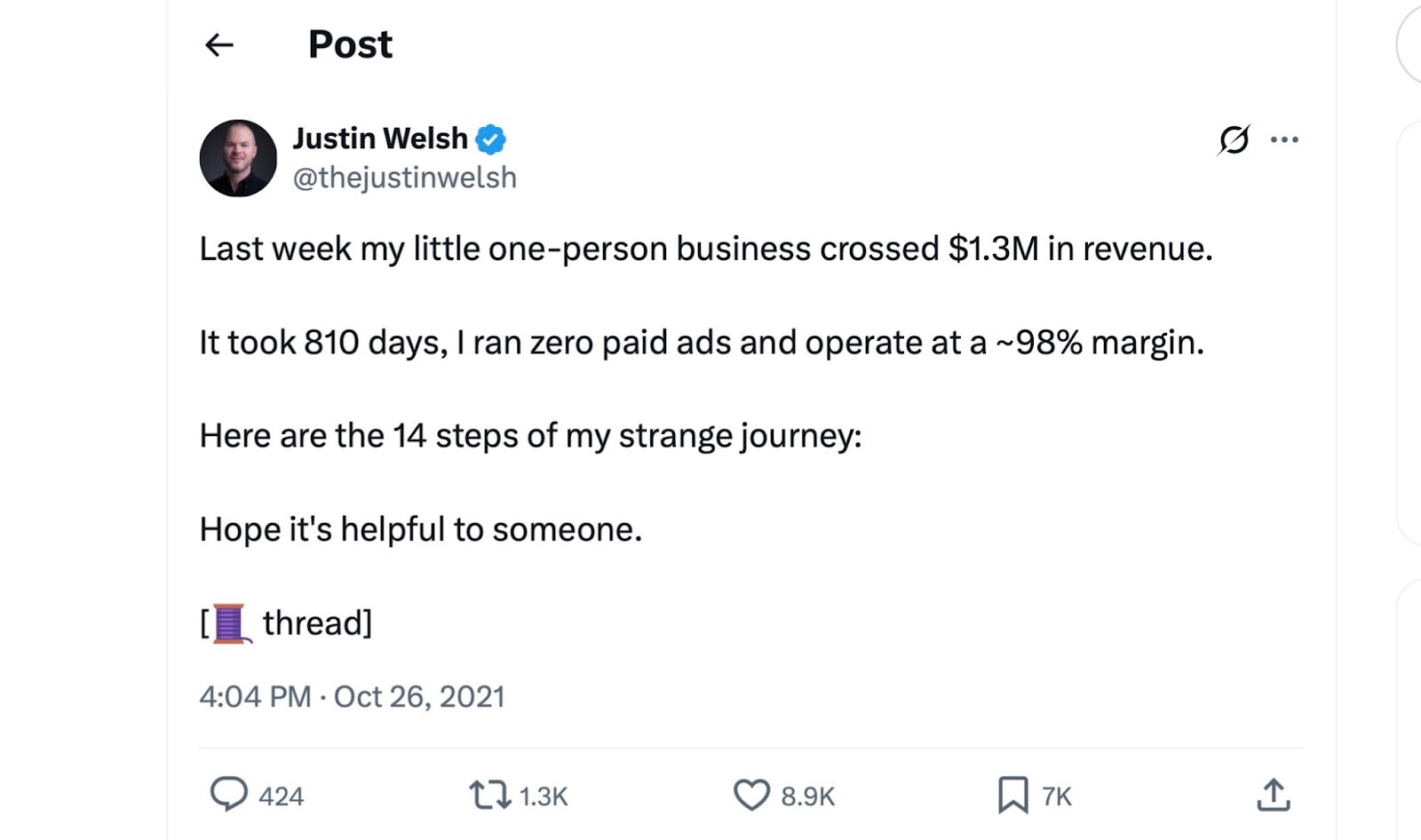
In October 2025, Growth in Reverse’s Chenell Bisillo reported that he built a solo business worth $1.7 million in just 3.5 years.
Before he launched one of his courses, he ran a presale. He first sold it at $99.
Then he increased it to $105. Next, he upped it to $110. Finally, he slowly shot it up to $150 when it was ready for launch.

The thing that most coaches, influencers, and course creators get wrong about scaling is thinking it’s only about getting more students to sign up.
Yes, Justin built an audience of over 360,000 on LinkedIn, but his real growth came from strategic pricing.

He focused on courses that offered high value. Also, he solved specific problems, such as helping people attract customers and grow their audience on LinkedIn.
His Content OS course teaches people how to write consistent, high-quality content for their brand and to build authority.
And he has testimonials from his customers to prove this.
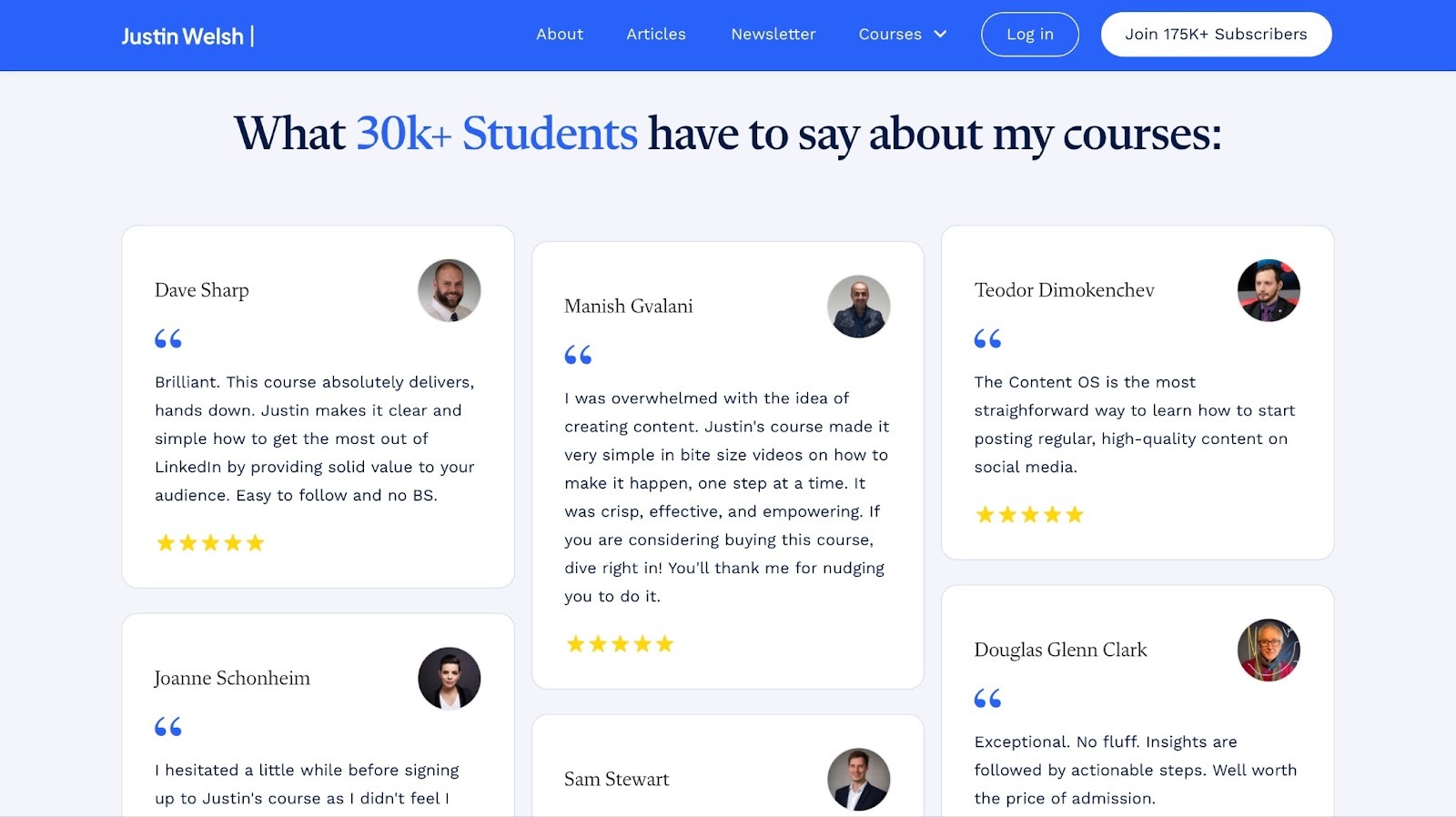
I would also say, apart from all that I’ve said, he raised his prices when demand for his courses grew. That’s what I mean by strategic pricing.
Like Justin, you can scale by making more from the audience you already have. Getting more students will always be a work in progress anyway.
Price your online course with confidence
I bet you're glad you kept reading.
To sum it all up, I walked you through a few common questions on pricing an online course. Then I talked about six steps to help you price your online course.
Finally, we looked at three common course pricing mistakes to avoid if you want to grow faster.
I'm 100% sure that everything I've said can help you hit or even pass that $10,000/month mark.
But, like I said earlier, you have to pair pricing your course with selling on the right platform. And yes, you need to offer real value, too.
That's non-negotiable.
Related articles
Ready for more? Check out these related articles that will keep your momentum going. They’re packed with easy-to-follow tips and tricks to help you supercharge your digital goods business.
Take it easy with Easytools
Focus on creating, and let Easytools handle the behind the scenes work.




